
Ain't I a Woman? Black Women and Feminism is a 1981 book by bell hooks titled after Sojourner Truth's "Ain't I a Woman?" speech. hooks examines the effect of racism and sexism on Black women, the civil rights movement, and feminist movements from suffrage to the 1970s. She argues that the convergence of sexism and racism during slavery contributed to Black women having the lowest status and worst conditions of any group in American society. White female abolitionists and suffragists were often more comfortable with Black male abolitionists such as Frederick Douglass, while southern segregationalists and stereotypes of Black female promiscuity and immorality caused protests whenever Black women spoke. hooks points out that these white female reformers were more concerned with white morality than the conditions these morals caused Black Americans.
Feminist science fiction is a subgenre of science fiction focused on theories that include feminist themes including but not limited to gender inequality, sexuality, race, economics, reproduction, and environment. Feminist SF is political because of its tendency to critique the dominant culture. Some of the most notable feminist science fiction works have illustrated these themes using utopias to explore a society in which gender differences or gender power imbalances do not exist, or dystopias to explore worlds in which gender inequalities are intensified, thus asserting a need for feminist work to continue.
Science fiction and fantasy serve as important vehicles for feminist thought, particularly as bridges between theory and practice. No other genres so actively invite representations of the ultimate goals of feminism: worlds free of sexism, worlds in which women's contributions are recognized and valued, worlds that explore the diversity of women's desire and sexuality, and worlds that move beyond gender.

Sexism is prejudice or discrimination based on one's sex or gender. Sexism can affect anyone, but it primarily affects women and girls. It has been linked to stereotypes and gender roles, and may include the belief that one sex or gender is intrinsically superior to another. Extreme sexism may foster misogyny, sexual harassment, rape, and other forms of sexual violence. Gender discrimination may encompass sexism. This term is defined as discrimination toward people based on their gender identity or their gender or sex differences. Gender discrimination is especially defined in terms of workplace inequality. It may arise from social or cultural customs and norms.
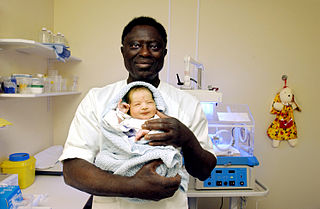
A gender role, also known as a sex role, is a social role encompassing a range of behaviors and attitudes that are generally considered acceptable, appropriate, or desirable for a person based on that person's sex. Gender roles are usually centered on conceptions of masculinity and femininity, although there are exceptions and variations.

Femininity is a set of attributes, behaviors, and roles generally associated with women and girls. Femininity can be understood as socially constructed, and there is also some evidence that some behaviors considered feminine are influenced by both cultural factors and biological factors. To what extent femininity is biologically or socially influenced is subject to debate. It is conceptually distinct from both the female biological sex and from womanhood, as all humans can exhibit feminine and masculine traits, regardless of sex and gender.
Marge Piercy is an American progressive activist and writer. Her work includes Woman on the Edge of Time; He, She and It, which won the 1993 Arthur C. Clarke Award; and Gone to Soldiers, a New York Times Best Seller and a sweeping historical novel set during World War II. Piercy's work is rooted in her Jewish heritage, Communist social and political activism, and feminist ideals.
Inez García (1941–2003) was a Hispanic woman who became a cause célèbre of the feminist movement when she was charged with the 1974 murder of a man who had raped her.
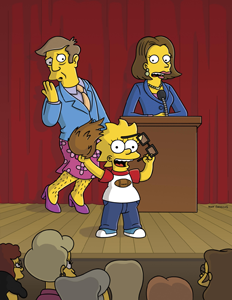
"Girls Just Want to Have Sums" is the nineteenth episode of the seventeenth season of the American animated television series The Simpsons. It originally aired on the Fox network in the United States on April 30, 2006.
Lipstick feminism is a variety of feminism that seeks to embrace traditional concepts of femininity, including the sexual power of women, alongside traditional feminist ideas. The concept emerged within the third-wave as a response to ideals created by previous movements, where women felt that they could not both be feminine and a feminist.
Sexualization is to make something sexual in character or quality or to become aware of sexuality, especially in relation to men and women. Sexualization is linked to sexual objectification. According to the American Psychological Association, sexualization occurs when "individuals are regarded as sex objects and evaluated in terms of their physical characteristics and sexiness." "In study after study, findings have indicated that women more often than men are portrayed in a sexual manner and are objectified. In addition, a narrow standard of physical beauty is heavily emphasized. These are the models of femininity presented for young girls to study and emulate." According to the Media Education Foundation's, Killing Us Softly 4: Advertising's Image of Women, the sexualization of girls in media and the ways women are portrayed in the dominant culture are detrimental to the development of young girls as they are developing their identities and understanding themselves as sexual beings.
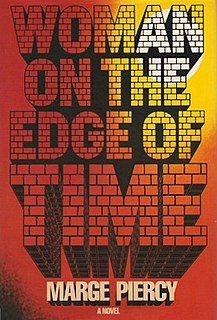
Woman on the Edge of Time is a 1976 novel by Marge Piercy. It is considered a classic of utopian "speculative" science fiction as well as a feminist classic. The novel was originally published by Alfred A. Knopf. Piercy draws on several inspirations to write this novel such as utopian studies, technoscience, socialization, and female fantasies. One of Piercy's main inspirations for her utopian novels is Plato's Republic. Piercy describes the novel as, "if only...". Piercy even compares Woman on the Edge of Time and another one of her utopian novels He, She, and It when discussing the themes and inspirations behind Woman on the Edge of Time.

Occupational sexism is discrimination based on a person's sex that occurs in a place of employment.
Gender essentialism is a theory that is used to examine the attribution of distinct, fixed, intrinsic qualities to women and men. In this theory, based in essentialism, there are certain universal, innate, biologically or psychologically based features of gender that are at the root of observed differences in the behavior of men and women. In Western civilization, it is suggested in writings going back to ancient Greece. With the advent of Christianity, the earlier Greek model was expressed in theological discussions as the doctrine that there are two distinct sexes, male and female created by God, and that individuals are immutably one or the other. This view remained essentially unchanged until the middle of the 19th century. This changed the locus of the origin of the essential differences from religion to biology, in Sandra Bem's words, "from God's grand creation [to] its scientific equivalent: evolution's grand creation," but the belief in an immutable origin had not changed.
The social construction of gender is a theory in feminism and sociology about the manifestation of cultural origins, mechanisms, and corollaries of gender perception and expression in the context of interpersonal and group social interaction. Specifically, the social construction of gender stipulates that gender roles are an achieved "status" in a social environment, which implicitly and explicitly categorize people and therefore motivate social behaviors.
"The Matter of Seggri" is a science fiction novelette by American writer Ursula K. Le Guin. It was first published in 1994 in the third issue of Crank!, a science fiction – fantasy anthology, and has since been printed in number of other publications. In 2002, it was published in Le Guin's collection of short stories The Birthday of the World: and Other Stories. "The Matter of Seggri" won the James Tiptree Jr. Award in 1994 for exploring "gender-bending" and has been nominated for other honors including the Nebula Award.
Native American feminism or Native feminism is, at its root, understanding how gender plays an important role in indigenous communities both historically and in modern-day. As well, Native American feminism deconstructs the racial and broader stereotypes of indigenous peoples, gender, sexuality, while also focusing on decolonization and breaking down the patriarchy and pro-capitalist ideology. As a branch of the broader Indigenous feminism, it similarly prioritizes decolonization, indigenous sovereignty, and the empowerment of indigenous women and girls in the context of Native American and First Nations cultural values and priorities, rather than white, mainstream ones. A central and urgent issue for Native feminists is the Missing and murdered Indigenous women crisis.
Norma Bailey is a Canadian film writer, producer, and director whose work is rooted in feminist and intersectional film theory. Bailey has directed several films, both in English and French and in various different genres, including fiction and non-fiction films. Her prolific career within the film industry has awarded her various awards and professional accolades including being named to the Order of Manitoba in 2010.
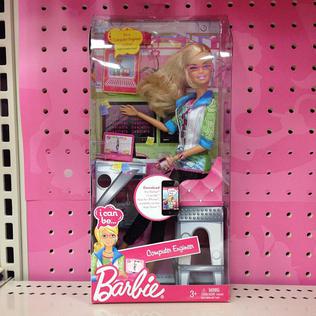
Computer Engineer Barbie is the 126th career version of Mattel's Barbie doll. In response to poll results indicating strong support for computer engineers, the doll set was created and introduced in 2010. In 2014, Mattel apologized for the accompanying book, I Can Be a Computer Engineer, after internet complaints that it represented Barbie as incompetent in the field, needing the help of men.
Feminist children's literature is the writing of children's literature through a feminist lens. Children's literature and women's literature have many similarities. Both often deal with being seen as weak and placed towards the bottom of a hierarchy. In this way feminist ideas are regularly found in the structure of children's literature. Feminist criticism of children's literature is therefore expected, since it is a type of feminist literature. Feminist children's literature has played a critical role for the feminist movement, especially in the past half century. In her book Feminism Is for Everybody: Passionate Politics, bell hooks states her belief that all types of media, including writing and children's books, need to promote feminist ideals. She argues "Children's literature is one of the most crucial sites for feminist education for critical consciousness precisely because beliefs and identities are still being formed". The cover of hooks' book, drawn by Laura DeSantis, depicts children alongside adults, showing the importance of the youth. The presence of feminism in children's literature has evolved over the years, but the overall message and goals have remained consistent.
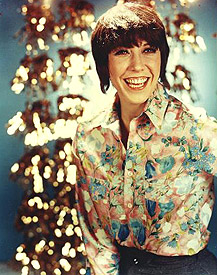
Feminist comedy refers to comedic acts and styles that further feminist principles, including gender equality and awareness of the social experience of gender. Comedy, the creative works with the intention of humor, has been historically dominated by men. The current comedy culture climate remains male-focused and is currently accepting of women comedians. The conversation surrounding gender-aware comedy has included articles and opinions from many male comedians and fans that are rooted in the idea that women aren’t funny, despite protest from successful female comedians and audiences. However, there is a difference between female humor and feminist humor. As a practice, feminist comedy is not solely comedy performed by women, as many women, especially early female comics, “served to reinforce… cultural stereotypes” and patriarchal views about women and gender. While some scholars have argued that this is because feminism may be antithetical to comedy, which is often described as an aggressive, necessarily masculine act in which the performer centers themselves, others have argued that humor's inclination to subvert hierarchies makes it a particularly effective communication platform for feminist comedians. Feminist comedy frequently references and discusses female-gendered issues and topics such as menstruation, rape, gender inequality, beauty norms, and machismo. Along the lines of intersectionality, which suggests that social identities and systems of oppression are interrelated, many feminist comedians also discuss homophobia, racism, and transphobia.








